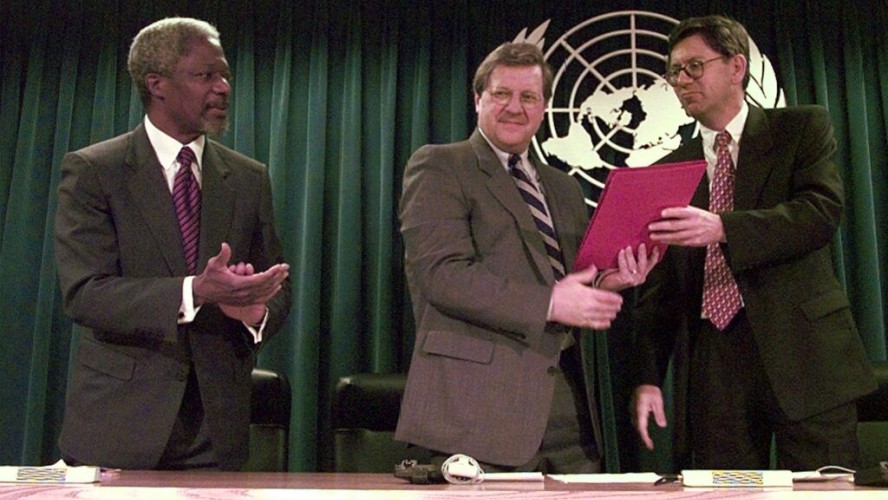
The Convention on the Prohibition of the Use, Stockpiling, Production and Transfer of Anti-Personnel Mines and on their Destruction is the international agreement that bans antipersonnel landmines. It is usually referred to as the Ottawa Convention or the Anti-Personnel Mine Ban Treaty.
History
The Convention was concluded by the Diplomatic Conference on an International Total Ban on Anti-Personnel Land Mines at Oslo on 18 September 1997.
In accordance with its article 15, the Convention was opened for signature at Ottawa, Canada, by all States from 3 December 1997 until 4 December 1997, and remained open thereafter at the United Nations Headquarters in New York until its entry into force on 1 March 1999.
Landmines come predominantly in two varieties: anti-personnel and anti-vehicle mines. Both have caused great suffering in the past decades and continue to kill and injure civilians and by-standers long after conflicts have ended. Anti-personnel mines are prohibited under the Ottawa Convention.
Since its inception more than two decades ago, the Convention has led to a virtual halt in global production of anti-personnel mines, and a drastic reduction in their deployment. More than 40 million stockpiled mines have been destroyed, and assistance has been provided to survivors and populations living in the affected areas. Vast numbers of mined and suspected hazardous areas have been declared free of landmines and released for productive use. As a result of these efforts, the number of casualties has sharply declined. Other welcome trends include: increases in national capacity to manage complex mine action programmes; the great progress in framing victim assistance in the wider context of disability; and the development of improved risk-reduction tools. The Mine Ban Convention has been a central framework for States in conducting mine action activities that led to all these remarkable achievements.
Joining the Mine Ban Convention
Signature
Pursuant to Article 15, the Convention was opened for signature by all States at Ottawa, Canada, from 3 to 4 December 1997, and at the United Nations headquarters in New York, from 5 December 1997 until its entry into force on 1 March 1999. 122 States took advantage of this possibility and signed the Convention in Ottawa. The Convention was signed by a total of 133 States.
Please note that the Convention is now closed for signature.
How to become a Party to the Mine Ban Convention
Pursuant to Article 16, the Convention is subject to ratification, acceptance or approval by the Signatories. Any State which has not signed this Convention may accede to it.
To become a party to the Convention the State concerned shall formally declare its consent to be bound by it in accordance with its constitutional arrangements for adherence to an international agreement. These constitutional arrangements generally require domestic action by the national parliament. Once the domestic requirements have been completed, an instrument of ratification, acceptance, approval or accession must be deposited with the Secretary-General of the United Nations, in his capacity as the Convention’s depositary.
Pursuant to Article 17, paragraph 2, the Convention shall enter into force for that State on the first day of the sixth month after the date on which that State has deposited its instrument of ratification, acceptance, approval or accession. However, any State may at the time of its ratification, acceptance, approval or accession, declare according to Article 18 that it will apply provisionally paragraph 1 of Article 1 of this Convention pending its entry into force.
The Articles of the Convention are not subject to reservations.
ICRC, in cooperation with the United Nations, have developed the following APLC Ratification Kit. The Ratification Kit contains a short description of the main obligations of the States parties in implementing the Convention, as well as a model instruments of accession to the Convention. It is available for download in English, Español, and Français.
For more information, please contact the APLC Executive Secretariat with the Office for Disarmament Affairs (Geneva branch), e-mail: aplc@unog.ch; or to Treaty Section, Office of Legal Affairs, United Nations, New York, NY 10017, e-mail: treaty@un.org.
Facilitation and clarification of compliance and other information
The States parties have agreed to consult and cooperate with each other with regard the implementation of the provisions of the Anti-Personnel Mine Ban Treaty, and to work together in a spirit of cooperation to facilitate compliance with their obligations under the Convention. For this purpose, Article 8 of the Convention provides for a series of steps that could be undertaken in order to clarify and resolve matters relating to compliance with the Convention, in particular, submitting requests for clarification by one or more States parties; making use of the UN Secretary-General’s good offices; considering the matter at a Meeting of the States parties; or convening a Special Meeting of the States parties.
This article also provides for the establishment of fact finding missions in case additional clarification is required. For such purposes, the Secretary-General of the United Nations” shall prepare and update a list of the names, nationalities and other relevant data of qualified experts provided by States Parties and communicate it to all States Parties. Any expert included on this list shall be regarded as designated for all fact-finding missions unless a State Party declares its non-acceptance in writing” (Article 8, paragraph 9 of the Convention).
Pursuant to the provisions of Article 8 of the Convention, the Office for Disarmament Affairs (Geneva Branch) is maintaining a roster of qualified experts, whose names have been communicated periodically by the States parties to the Secretary-General of the United Nations at his/her invitation.
For communicating the names of their qualified experts, the States parties use the Registration form below: